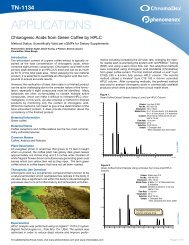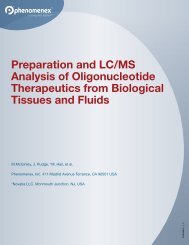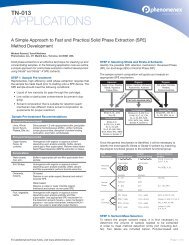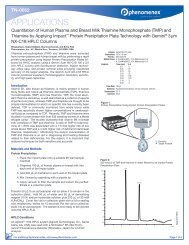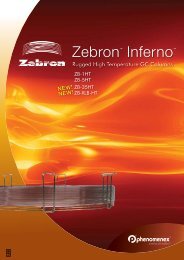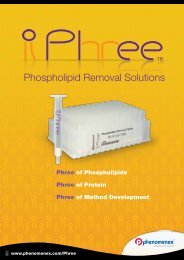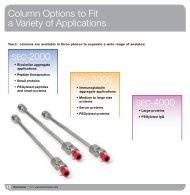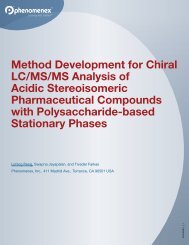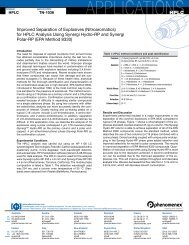column phase selection guide troubleshooting tools ... - Phenomenex
column phase selection guide troubleshooting tools ... - Phenomenex
column phase selection guide troubleshooting tools ... - Phenomenex
You also want an ePaper? Increase the reach of your titles
YUMPU automatically turns print PDFs into web optimized ePapers that Google loves.
PEAKS<br />
NO PEAKS<br />
GHOST PEAKS<br />
TAILING PEAKS<br />
BROAD SOLVENT FRONTS<br />
Possible Cause:<br />
System<br />
• Clogged syringe ............................................................<br />
• Leaks ............................................................................<br />
• No carrier gas ...............................................................<br />
• Detector OFF or not lit ...................................................<br />
• Wrong injection port ......................................................<br />
• Clogged inlet sleeve ......................................................<br />
Column<br />
• Broken <strong>column</strong> ..............................................................<br />
• Plugged <strong>column</strong> ............................................................<br />
Possible Cause:<br />
System<br />
• Septum bleed ................................................................<br />
• Carry over .....................................................................<br />
• Dirty inlet ......................................................................<br />
• Contaminated gas .........................................................<br />
• Outgassing from traps ..................................................<br />
• Contaminated gas lines .................................................<br />
Column<br />
• Sample contaminated ...................................................<br />
Sample<br />
• Contaminated sample ...................................................<br />
• Contaminated flush solvent ...........................................<br />
• Possible sample degradation .........................................<br />
Possible Cause:<br />
• Contaminated or active injector liner or <strong>column</strong> ............<br />
• Dead volume due to poorly installed liner or <strong>column</strong> .....<br />
• Ragged <strong>column</strong> end ......................................................<br />
• A bad match between the polarities of stationary .........<br />
<strong>phase</strong> and the solvent<br />
• A cold region in the sample flow path ...........................<br />
• Debris in the liner or <strong>column</strong> .........................................<br />
• Injection takes too long .................................................<br />
• Split ratio is too low .......................................................<br />
• Overloading the inlet ....................................................<br />
• Some types of compounds such as alcoholic ...............<br />
amines and carboxylic acids tend to tail<br />
Possible Cause:<br />
• Bad <strong>column</strong> installation .................................................<br />
• Injector leak ..................................................................<br />
• Injection volume too large .............................................<br />
• Injection temperature too low ........................................<br />
• Split ratio is too low ......................................................<br />
• Column temperature too low .........................................<br />
• Initial <strong>column</strong> temperature too high ................................<br />
for splitless injection<br />
• Purge time too long (splitless injection) .........................<br />
Suggested Remedy:<br />
Clean or replace syringe.<br />
Check injector for leaks. Make sure <strong>column</strong> is properly installed in detector.<br />
Turn on carrier gas.<br />
Ignite or turn on detector. Reduce sample size or gas flows if solvent blew out detector.<br />
Verify correct injection port.<br />
Replace inlet liner.<br />
Inspect <strong>column</strong> and verify flow at <strong>column</strong> outlet.<br />
Cut off 5-10 cm of <strong>column</strong> ends and reinstall <strong>column</strong>. Verify flow at <strong>column</strong> outlet.<br />
Suggested Remedy:<br />
Replace septum with high-temperature, low-bleed septum.<br />
Increase final temperature and hold. Rinse syringe better.<br />
Replace inlet liner.<br />
Replace filters, scrubbers, or service purifiers. Use higher purity gasses.<br />
Replace traps.<br />
Replace or clean gas lines.<br />
Cut 50-100 cm from injector side of <strong>column</strong>. Perform an extended conditioning step. Solvent<br />
rinse <strong>column</strong>. Use glass wool in liner or decrease injection temperature, or replace <strong>column</strong>.<br />
Remake sample with higher purity/fresh solvents and clean glassware.<br />
Replace syringe flush solvent with fresh/pure solvent.<br />
Make new sample. Store samples using proper procedures. Reduce introduction of catalysts<br />
or reactive analytes in sample. Store samples in opaque or dark containers.<br />
Suggested Remedy:<br />
Clean or replace injector liner. Don’t use glass wool in the liner. Solvent rinse or replace<br />
the <strong>column</strong>.<br />
Confirm by injecting inert peak (methane). If it tails, <strong>column</strong> is not properly installed.<br />
Reinstall liner and <strong>column</strong> as necessary.<br />
Score the tubing lightly with a sapphire scribe or a ceramic scoring wafer before breaking it.<br />
Examine the end. If the break is not clean and the end square, cut the <strong>column</strong> again. Point<br />
the end down while breaking it, and reinstall the <strong>column</strong> while installing a nut and ferrule.<br />
This will prevent fragments from entering the <strong>column</strong>.<br />
Change the stationary <strong>phase</strong>. Usually polar analytes tail on non-polar <strong>column</strong>s,<br />
or dirty <strong>column</strong>s.<br />
Remove any cold zones in the flow path.<br />
Clean or replace the liner. Cut 10 cm off the end of the <strong>column</strong> and reinstall it.<br />
Improve injection technique.<br />
Increase split ratio to at least 20:1.<br />
Decrease the sample volume or dilute sample.<br />
Try a more polar <strong>column</strong>. Make a derivative of the sample.<br />
Suggested Remedy:<br />
Reinstall <strong>column</strong>.<br />
Find and fix leak.<br />
Decrease sample size or dilute 1:10.<br />
Increase injection temperature so the entire sample is vaporized “instantly.” An injection<br />
temperature higher than the temperature limit of the <strong>column</strong> will not damage the <strong>column</strong>.<br />
Increase split ratio.<br />
Increase <strong>column</strong> temperature. Use a lower boiling point solvent.<br />
Decrease the initial <strong>column</strong> temperature. Use a less volatile solvent so the initial <strong>column</strong> temperature<br />
is at least 10 °C below the boiling point of the solvent. Use a shorter purge activation time.<br />
Use a shorter purge activation time.<br />
BASELINE<br />
POSSIBLE CAUSES<br />
FOR BASELINE INSTABILITY<br />
SYSTEM<br />
• Leaks, O 2 influx<br />
• Column bleed<br />
• Septum bleed<br />
• Contaminated gases<br />
• Unequilibrated<br />
• Dirty detector<br />
• Dirty inlet<br />
• Improper flow rates<br />
• Pneumatic temperature change<br />
REFERENCE<br />
PARAMETERS UNIT SYMBOLS<br />
Retention Time of<br />
an Unretained Solute<br />
Retention Time,<br />
Measured from the Start<br />
s t o<br />
Adjusted Retention Time s t ’ R = t R - t o<br />
Peak Width<br />
(Base)<br />
Peak Width<br />
(Half Height)<br />
s<br />
s<br />
s<br />
t R<br />
W<br />
W1/2<br />
t o<br />
COLUMN<br />
• Bleed contamination<br />
• Liquid leak detector<br />
contamination<br />
Capacity Factor<br />
–<br />
(Retention Factor)<br />
k = t ’ R<br />
t o<br />
k<br />
Selectivity Factor – 2 t ’<br />
a = =<br />
R2<br />
k 1 t’ R1<br />
t’<br />
Resolution – R2<br />
-<br />
R s = 2<br />
t, R1<br />
( W 1 + W 2<br />
)<br />
Number of Theoretical Plates – N = 5.54<br />
t R t<br />
(W1/2) 2 R<br />
= 16( W ) 2<br />
t’<br />
Number of Effective Plates – R t’<br />
N eff = 5.54 (W1/2) 2 R<br />
= 16 ( W) 2<br />
Column Length cm L<br />
Height Equivalent of a<br />
Theoretical Plate (Plate Height)<br />
cm H =<br />
Effective Plate Height cm H eff =<br />
Linear Velocity of the<br />
Mobile Phase<br />
Pressure Conversions<br />
cm s -1 U =<br />
L<br />
N<br />
L<br />
N eff<br />
L<br />
t o<br />
1 bar = 100 kPa<br />
1 atm = 101.3 kPa<br />
1 psi = 6.9 kPa<br />
SAMPLE<br />
• Carry over<br />
• Depolymerization agents<br />
(HCl, KOH, etc.)<br />
HOW TO<br />
DECREASE<br />
PEAK WIDTH<br />
1. Use a More<br />
Efficient Column<br />
• Packed -<br />
smaller particles, packed<br />
more tightly<br />
• Capillary -<br />
smaller ID, thinner film<br />
2. Optimize Method<br />
Parameters<br />
• See van Deemter<br />
Plots for optimal flow<br />
rates of carrier gases<br />
• Optimize temperature<br />
profiles<br />
3. Reduce Sample Size<br />
• To avoid <strong>column</strong><br />
overloading<br />
4. Reduce Dead<br />
Volume in System<br />
• Follow manufacturer’s<br />
recommended<br />
Installation Instructions<br />
• Eliminate any leaks<br />
• Optimize detector flows<br />
FRONTING PEAKS<br />
SPLIT PEAKS<br />
Possible Cause:<br />
• Column overloading .......................................................<br />
Possible Cause:<br />
• Poor (jerky or erratic) injections .....................................<br />
• Bad <strong>column</strong> installation .................................................<br />
• Fluctuations in <strong>column</strong> temperature ..............................<br />
• Mixed sample solvent for splitless ................................<br />
or on-<strong>column</strong> injections<br />
• When using injection techniques that ............................<br />
require “solvent effect” refocusing such as splitless<br />
injection, the solvent must form a compact, continuous<br />
flooded zone in the <strong>column</strong>. If the solvent does not wet<br />
the stationary <strong>phase</strong> (<strong>column</strong> lining) sufficiently, as<br />
might be the case for methanol used with a nonpolar<br />
stationary <strong>phase</strong>, the solvent flooded zone may be<br />
several meters long and not of uniform thickness. This<br />
will result in broad and distorted peaks because the<br />
solutes will not be refocused into a narrow band near<br />
the beginning of the <strong>column</strong>.<br />
Suggested Remedy:<br />
Reduce the injection volume (increasing sensitivity, if necessary), increase split<br />
ratio, or use a <strong>column</strong> with greater capacity. Columns with larger diameters<br />
or thicker stationary <strong>phase</strong> coatings generally have larger sample capacities;<br />
however, resolution may be reduced.<br />
Suggested Remedy:<br />
Use smooth, steady plunger depression. Use autosampler.<br />
Reinstall <strong>column</strong>.<br />
Repair temperature control system. Calibrate GC oven.<br />
Use single solvent.<br />
Installing a retention gap (5 meters of uncoated<br />
but deactivated <strong>column</strong>) ahead of the chromatographic<br />
<strong>column</strong> may reduce or eliminate this problem.<br />
NON-REPRODUCIBLE RETENTION TIMES<br />
Possible Cause:<br />
System<br />
• Leaks .............................................................<br />
• Erratic flow controller ......................................<br />
• Unstable oven temperature ..............................<br />
• Pneumatic temperature change ......................<br />
• Line pressure change ......................................<br />
• Injection technique ..........................................<br />
Column<br />
• Polarity changing from contamination ..............<br />
• Adsorption .......................................................<br />
Sample<br />
• Concentration solute/stationary .......................<br />
<strong>phase</strong> insolubility<br />
Suggested Remedy:<br />
Check injector for leaks. Make sure <strong>column</strong> is properly installed in detector.<br />
Verify flows. Fix/replace flow controller if necessary.<br />
Calibrate oven. Possibly replace thermocouple.<br />
Redirect oven exhaust. Regulate room temperature.<br />
Install dual stage regulator.<br />
Standardize a reproducible injection technique.<br />
Cut 50-100 cm from injector side of <strong>column</strong>; perform an extended<br />
conditioning step. Solvent rinse <strong>column</strong>. Use glass wool in liner or decrease<br />
injection temperature; or replace <strong>column</strong>.<br />
Increase final temperature in program with hold time. Remove 50-100 cm<br />
from injector side of <strong>column</strong>.<br />
Use retention gap. Change <strong>column</strong> <strong>phase</strong>.<br />
Contact <strong>Phenomenex</strong> to get your<br />
FREE COPY of our GC Troubleshooting Guide<br />
PO52200710_I<br />
Australia<br />
t: 02-9428-6444<br />
f: 02-9428-6445<br />
auinfo@phenomenex.com<br />
Canada<br />
t: (800) 543-3681<br />
f: (310) 328-7768<br />
info@phenomenex.com<br />
France<br />
t: 01 30 09 21 10<br />
f: 01 30 09 21 11<br />
franceinfo@phenomenex.com<br />
Italy<br />
t: 051 6327511<br />
f: 051 6327555<br />
italiainfo@phenomenex.com<br />
The Netherlands<br />
t: 030-2418700<br />
f: 030-2383749<br />
nlinfo@phenomenex.com<br />
Puerto Rico<br />
t: (800) 541-HPLC<br />
f: (310) 328-7768<br />
info@phenomenex.com<br />
www.phenomenex.com<br />
<strong>Phenomenex</strong> products are available worldwide. For the distributor in your country,<br />
contact <strong>Phenomenex</strong> USA, International Department at international@phenomenex.com<br />
Austria<br />
t: 01-319-1301<br />
f: 01-319-1300<br />
anfrage@phenomenex.com<br />
Belgium<br />
t: +31 (0)30-2418700<br />
f: +31 (0)30-2383749<br />
beinfo@phenomenex.com<br />
Denmark<br />
t: 4824 8048<br />
f: 4810 6265<br />
nordicinfo@phenomenex.com<br />
Finland<br />
t: (09)4789 0063<br />
f: +45 4810 6265<br />
nordicinfo@phenomenex.com<br />
Germany<br />
t: 06021-58830-0<br />
f: 06021-58830-11<br />
anfrage@phenomenex.com<br />
Ireland<br />
t: 01 247 5405<br />
f: +44 1625-501796<br />
eireinfo@phenomenex.com<br />
Luxembourg<br />
t: +31 (0)30-2418700<br />
f: +31 (0)30-2383749<br />
nlinfo@phenomenex.com<br />
Mexico<br />
t: (55) 5018 3791<br />
f: (310) 328-7768<br />
tecnicomx@phenomenex.com<br />
New Zealand<br />
t: 09-4780951<br />
f: 09-4780952<br />
nzinfo@phenomenex.com<br />
Norway<br />
t: 81 00 20 05<br />
f: +45 4810 6265<br />
nordicinfo@phenomenex.com<br />
United Kingdom<br />
t: 01625-501367<br />
f: 01625-501796<br />
ukinfo@phenomenex.com<br />
All other countries:<br />
Corporate Office USA<br />
t: (310) 212-0555<br />
f: (310) 328-7768<br />
info@phenomenex.com



